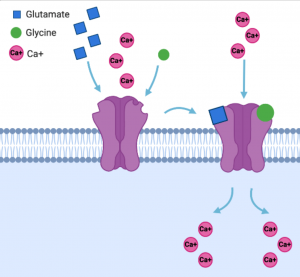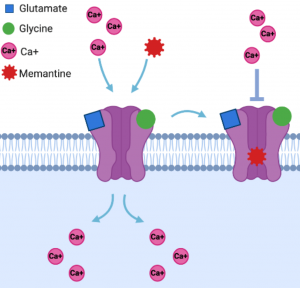7.2.2 – N-methyl-D-aspartate Antagonists
N-methyl-D-aspartate (NMDA) receptors are an important class of glutaminergic receptors found in the brain. The receptor contains two different binding sites for both glutamate and glycine, and both molecules have to be present for activity to occur. Alternatively, the molecule NMDA can also selectively bind to the glutamate binding site to activate the receptor along with glycine. When it is activated, a conformational change allows the receptor to open up so that positive ions like calcium can pass through the cell membrane. The high permeability of these receptors to calcium ions acts to amplify action potentials passing through the membrane. However, this amplification does not always lead to positive outcomes. In a normal brain, NMDA receptors are extremely important regulators of learning and memory, because calcium ions are correlated with synaptic plasticity. However, in Alzheimer’s disease, glutaminergic neurons have been shown to be overactive. The NMDA molecule is considered a toxin, as a phenomenon known as excitotoxicity leads to neuronal death. Specifically in Alzheimer’s disease, excessive stimulation causing neuronal death is a result of excessive concentrations of glutamate.
NMDA antagonists are a class of drugs that function in order to block the influx of calcium ions, thereby preventing the dangerous excitotoxicity related to the overactive glutaminergic neurons. They differ from traditional acetylcholinesterase inhibiting drugs in that they are neuroprotective, meaning that they can directly prevent cell and tissue death. The preservation of neurons allows for important signaling pathways in the brain to continue unimpeded, allowing for the preservation of memory and language. The NMDA antagonist that is commonly prescribed in the treatment of Alzheimer’s disease is memantine. The mode of action for memantine is uncompetitive, meaning it acts to block the NMDA receptor channel rather than an active or allosteric site. Because it is both uncompetitive and has a low affinity for the receptor, memantine is able to curb the excessive excitement of neurons while maintaining normal function which is essential in a healthy human brain. Other alternatives that have been researched to act on the NMDA receptor could not be tolerated in clinical trials because their higher affinities for the receptor or competitive inhibition of its substrates hampered normal neuronal function. Memantine only enters the NMDA receptor channel when it has been open for an extended period of time, and works quickly so that excessive concentrations do not build in the receptor channel and affect normal neuronal function.
The side effects of memantine are localized to the head, such as dizziness and headaches. However, though the drug has been shown to improve behavioural and psychological symptoms of Alzheimer’s disease, specific studies have paradoxically also shown side effects of confusion and agitation. Memantine has been shown to be less effective than acetylcholinesterase inhibitors, and is usually considered only as a second alternative if other drugs cannot be tolerated. Combination therapy using both memantine and acetylcholinesterase inhibitors has shown some promise in treating cognitive decline and behavioural effects seen in severe Alzheimer’s disease, but has not shown significant results for mild to moderate forms of the disease.


